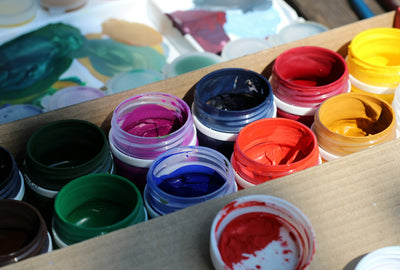We live in a time of rapid technological developments. Especially in product labelling, entrepreneurs and designers recognize the need to constantly rethink and improve their techniques. Laser marking, of course also with our Mr Beam laser cutter, is taking on an increasingly dominant place. But why are more and more people choosing this needle embossing alternative and turning away from traditional needle embossing? Let’s dive into the fascinating world of laser marking together!
Laser marking as a needle embossing alternative vs. needle embossing: An in-depth look

When you embark on the journey to find the right marking process for your product, you will inevitably stumble across two prominent methods: laser marking and dot peen stamping. Both techniques aim to leave lasting marks on materials, but their approach and results couldn't be more different.
First, needle embossing. As the name suggests, this method uses an oscillating carbide needle. The needle leaves a series of dots on the material through targeted stitches, creating the desired design or information. It is essentially a mechanical process: an instrument physically hits a material and modifies it. Think of the tattoo artist putting ink into the skin - except there is no dye used, and the surface is worked on by products rather than people.
Laser marking as a dot peen alternative, on the other hand, seems like magic at first glance. Instead of having physical contact with the material, laser marking uses focused light to alter the material. There is no touch, no direct pressure - just light controlled so precisely that it can produce the finest details and intricate patterns on a variety of materials. And it goes even further: While needle embossing leaves physical marks in the form of punctures, laser marking as a needle embossing alternative can deliver different results depending on the setting and material, from colour changes to deeper engravings.
What both techniques have in common is their primary goal: permanent labelling. Both processes are designed to create markings that will last over time. But that's where the similarities end.
The biggest difference lies in the applicability to different materials. While needle embossing reaches its limits with extremely hard materials and requires specialized tools, laser marking is characterized by its universality. It can be easily applied to metal, wood, plastic and even textiles.

Finally, I would like to point out the aesthetics. The markings created by needle embossing are often coarser and less defined than the fine, crisp lines created by a laser. So if the visual presentation of your marking is of utmost importance, laser marking will certainly be the superior choice.
Advantages and Disadvantages: Your comprehensive decision-making guide
In the world of marking technologies, you and your company face a choice between two formidable rivals: dot peening and laser marking. Each procedure has its own strengths and weaknesses. Let’s dive deep and examine these thoroughly to ensure your choice is based on sound knowledge.
Needle embossing:
Advantages:
- Resistance: The lettering is mechanically anchored deeply in the material, making it resistant to abrasion and external influences
- Independence from colour: Since no ink or paint is used, there is no risk of fading or smudging
Disadvantages:
- Limited material compatibility: Needle embossing reaches its limits with very hard materials, such as some hard metals
- Noise: The process is often loud due to the mechanical processing of the material
- Lack of finesse: Compared to laser marking, the results are often coarser and less detailed
- Maintenance intensity: The needles, especially when machining hard metals, tend to break and need to be replaced
Laser marking as a dot peen alternative using Mr Beam

Advantages:
- Versatility: Mr Beam works precisely on a variety of materials - from metal (with the laser marking spray) to wood to textiles
- High-quality results: The labels are fine, clear and durable, making them ideal for demanding designs and applications
- Quiet and clean: In contrast to dot peening, laser marking with Mr Beam is almost silent and produces no chips or waste
- Low maintenance: Because it is a non-contact process, no parts wear out and the machine stays in top condition for longer
- Efficiency and speed: With its advanced technology, Mr Beam enables short processing times and high repeat accuracy
- Easy to use: Once set up, Mr Beam is easy to use. Projects are simply created in the usual graphics program and sent to the laser cutter
Disadvantages:
- Initial investment: Although the Mr Beam laser cutter is an economically wise decision in the long term, the initial investment can be higher than traditional embossing methods. Many users earn money from home with Mr Beam and have become self-employed part-time.
If you look at the bigger picture, you'll find that both methods come with their own benefits and challenges. But the Mr Beam laser cutter as a dot peen alternative impresses with its numerous advantages and its applicability on a variety of projects. It's not just about labelling, but also about the precision, efficiency and versatility that can take your business to a new level.
Application examples: The fascinating world of labelling techniques
Choosing the right labelling method depends not only on the respective advantages or disadvantages, but also on the area of application. Join me as I look at some inspiring examples of how needle embossing and laser marking with the Mr Beam laser cutter prove themselves in different industries and projects.
You often come across needle embossing in the automotive industry. Think of the many vehicle components that often need to be provided with serial numbers or other identifying features. The high stress on parts requires a robust and long-lasting labeling method. The needle embossing ensures that these markings remain even after years of use and under different weather conditions.
But needle embossing also has its right to exist in jewellery making. Some artists and designers appreciate the special feel that this technique creates. It conveys a certain authenticity that is particularly appreciated in unique pieces.
But now turn to the Mr Beam laser cutter as a needle embossing alternative and be amazed at the versatility of laser marking. In the electronics industry, where precision and miniaturization dominate, lasers rely on the ability to create extremely fine and detailed markings. On a small microchip or a complex circuit board layout, information is required not only for identification but also for orienting technicians. Here the Mr Beam delivers precise, clear and lasting results.

In the world of art and design, Mr Beam's dot peen alternative opens up completely new horizons for artists. Whether it's making delicate cuts in paper for a paper-cutting artwork or personalized engravings on stainless steel and wood, the laser offers a precision and versatility that is difficult to achieve using traditional methods.
Lastly, but no less impressively, laser marking is used in the medical, dental and orthopedic industries to mark instruments. Imagine how important it is to correctly identify each surgical instrument. The Mr Beam ensures that every pliers, every scalpel and every drill is labelled clearly, clearly and hygienically.
Final reflection: The art of labelling in a new light

Product labelling is an essential element in modern manufacturing and design. While needle embossing certainly has its merits, laser marking as a needle embossing alternative, especially with the Mr Beam laser cutter, offers significantly more advantages in terms of efficiency, precision and range of applications. So if you're thinking about investing in new marking technology or rethinking your current process, laser marking is certainly worth a second (or third) look. And who knows? Perhaps it will soon become the new norm in product labelling. Stay innovative and open to the technologies of tomorrow!



